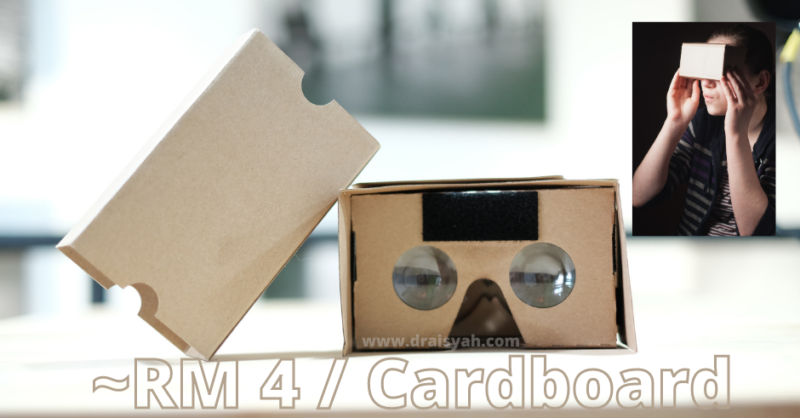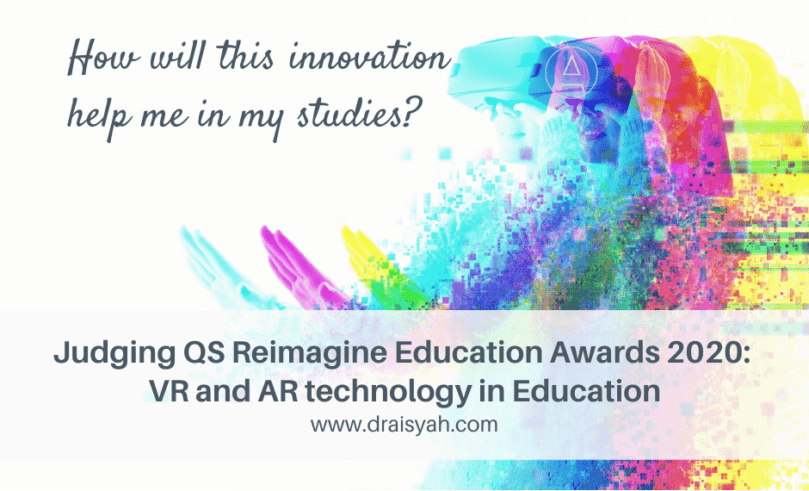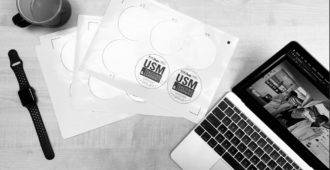It’s my fourth year of serving as a judge for QS Reimagine Education Awards. This time, I requested for VR and AR technology category – and was assigned to applications from many parts of the world including Australia, Africa, Europe and the US showcasing projects in STEM subjects, social sciences and from design schools.
While I am unable to reveal the specifics of the applications, in this blog post I share my thoughts on judging teaching competitions and several ways VR and AR technology can be used in education and training.
Started about seven years ago, QS Reimagine Education is the global conference and competition for teaching and learning innovations. The conference prides itself on being “the world’s largest awards program for innovative pedagogies”. Its awards are called The ‘Oscars’ of Education.
To those who might be wondering, Is this the same QS (Quacquarelli Symonds) for world’s university ranking? The answer is yes.
QS Reimagine Education has attracted increasing number of applications for the awards.
From over 400 applicants around the world in 2014, the year my application was shortlisted for the awards. And now in 2020, QS Reimagine Education received over 1500 applicants.
Over the years, QS Reimagine Education has added more categories, more defined and representative of the efforts in teaching and learning, with partnerships in the likes of Amazon, Google.
And the competition is getting stiffer; many educators, institutions and tech companies bank on big innovative ideas that bring about long-term impacts to students. The young generations who are joining the workforce and becoming a contributing member of the society and global communities in the age of 4IR.
Through QS Reimagine Education, I had the privilege of learning about ideas, practices and innovations taking place around the world – many are excellent – in categories such as hybrid & online learning, mobile applications and artificial intelligence in education.
Judging innovations in teaching competitions
In addition to Reimagine Education awards, I had served as judge for several teaching competitions.
As judge, I would always put myself – first as a student. Or an instructor, if the project is for instructors or teachers.
I wonder, as a student: How will this innovation help me in my studies? How useful will it be in improving my understanding? Or how could it make me more attractive to potential employers?
In the other shoes, so to speak, as a judge, I would often ask myself: What’s the problem(s) the innovators want to solve? What are its strengths and limitations?
In one sense, I am not judging the technology but rather how would the technology or innovation bring about impact to a student’s learning, outcomes or life on campus?
Since technology is a part of life nowadays, some institutions took the golden opportunity to enhance students’ life. It is also a part of re-branding exercises for the institutions going into the digital world.

I remember the time when I was assigned to evaluate campus-wide efforts by several universities – building expansive ICT infrastructure.* Even though it’s campus-wide – what I found interesting – the systems were designed with students in mind, for instance, in assisting students to manage their time, peer-learning and studies. What a thoughtful design =)
In many teaching competitions, however, one would encounter ‘me-too’ projects or products. For example, when Pokemon Go became an overnight success, it’s no surprise that a number of teaching innovation projects started using this ‘tech template’ for their lessons.
Using such template felt ‘forced’, in my opinion. Lessons have to fit into the templates, and not the other way around.
When that happens, usually the purpose of the ‘re-packaged’ idea / project is likely to satisfy a KPI or looking good or for profit. It appears, unfortunately, less likely towards solving a student’s or teacher’s problem.
The Pandemic + VR and AR Technology in Education
This year, due to Covid-19 pandemic, I wanted to see what has changed in education? Since educators around the world ‘had’ to resort to technology, I wonder – has the pandemic ‘helped’ pushed the boundary?
Anything new in the frontier of technology in education?
What I find exciting in this VR and AR technology category is to see how the technology being shaped for education – from primary to higher education and professionals.
Some reported that the pandemic got them quicker, in terms of putting the VR technology out there – due to the high demand – in particular, for remote teaching delivery and improving students’ engagement online.

As VR viewers are getting cheaper and easier to source, e.g. Google Cardboard is cheaper than a Family Mart boba tea, perhaps it’s time to think of bringing the worlds to the students.
Below are several ways to innovate your teaching with VR technology:
VR and sciences: Where would it take you?
VR and AR technology can help students who have trouble ‘seeing’ the invisible worlds in sciences. Many concepts in science subjects e.g. Chemistry, Biology, Physics, Astronomy are ‘different’ – some seemingly unrelated to the world we live in. It’s like learning to navigate and understand entirely new worlds with ‘strange’ landscapes and terminologies.
Learning sciences through VR and AR tech would be great for students. For example, a virtual exploration inside the chambers of a heart, learning about its valves, ECG and how they work. This is a walk-through experience via VR and AR technology.

In chemistry, VR and AR technology can help students understand better by ‘seeing’ the virtual world of chemical compounds, atoms and reactivity. For example, translating a 2D chemical structure into its molecular orbitals / energy in 3-dimensions.
Understanding molecular orbitals and its involvement in chemical reactions are important concepts in chemistry; in my case – teaching the chemistry of drugs.
Bringing the ‘unseen’ drug structure to students
I remember my experience as a lecturer. Teaching chemistry had been limited to 2-dimensional experience. It was great for me but less helpful to students.
And I realised some of my former students lacked the ability to imagine that unseen molecular world, which usually led to poor understanding.

Limiting myself to teaching chemistry in 2D (whiteboard) or in a presentation mode meant that I was unable to bring about the rich sensory feelings to students. Eventually year in, year out, many students found chemistry boring, dry and difficult.
As an educator, such students’ perceptions in learning could be demoralising. That often results in one continuing to deliver dull lectures/lessons because he/she believes in the saying that ‘you can’t teach an old dog new tricks’.
Well… The power is in your hands.
Back then, molecular models were expensive. VR and AR technology were still at infancy – plus it’s very costly to develop one for teaching.
Towards improving my students’ understanding, I went for a low-cost ‘technology’ i.e. balloons. Balloons were folded in a pentagon-like shape to mimic the structure and orbitals of penicillin.

My students played with balloons while learning chemistry in a visual and tactile manner. They had fun, to say the least 😉
I observed similar excitement amongst the panelists during my presentation at university level teaching competition. It’s told as a story in my book Elevate.
Today, if given an opportunity, I’d love to work on a VR project =)
VR and AR technology: Seeing the Worlds in the Past and the Future
The second and third uses of VR technology in education is visualising the past and the future worlds.
Students would be able to immerse themselves in history if the past is re-created as a tour or a story. Like an RPG video game. In the virtual world, they could also be a part of the ‘history’ and learn to think constructively about the events.
The immersive learning, offered by VR, could help students towards re-thinking how they could ‘change history’ to lead a better world.
On this note, I’m not sure if VR technology would one day replace history books or textbooks – bearing in mind of its costs and multi-disciplinary nature of creating a VR media. Food for thought.

VR and AR technology also seem quite promising in seeing the future. It could have a role in re-imagining our cities, city-scapes, built environment and land utilisation – a facility for students at architecture and urban planning schools.
Alternatively, it could also be used in small projects, for instance re-imagining and designing another form of a classic chair making it more ergonomic and contemporary.
Being able to ‘see’ how well a customer fit in the new chair design – before it goes into production in China – could cut down costs for product design students and allow collaborative iterations over distance.
VR and AR technology in Education, in sum
Take a look at this 360 / VR tour in Kuala Lumpur, Malaysia. Though the pandemic has led to limited and restricted international travels, perhaps until Q2 of 2021, immersing oneself in a foreign land and its cultures is virtually possible these days. A potential project for language studies and tourism.
Furthermore, restricted air travels have resulted in the push for VR and AR technology in training and professional competency. Since expert trainers or doctors are unable to travel to training centres or workshops, undertaking virtual hands-on operations – guided and assessed by experts on a VR platform – could be a new frontier for healthcare professionals. This blog post lists real cases of AR apps in improving patient care.
Food for thought in this uncertain times, post-pandemic.
What I learned from the experience judging the innovative efforts incorporating VR and AR in teaching and training is the immersive and interactive nature of a virtual reality technology that other technologies unable to replicate. Yet.
VR and AR technology seem promising in bringing students and instructors into another world – the unseen, the past and the future.
With that in mind, the possibility of going beyond a VR walk-through that is, the use of the VR and AR technology as a teaching aid in training and re-designing a better future sounds quite fascinating.
I had a great time judging the competition. Hope to see many more interesting pedagogical innovations in next year’s QS Reimagine Education.

Further readings
If you wish to know more about VR and AR technology, do take a look at these websites: EchoAR, Edu Plus and Jasoren.
For a survey of how VR could enhance our lives, read this (long) opinion article.
For a more overall view of VR in education, read Jamie Justice’s posts – this post ‘2020: The Year of AR and VR for Education and Training’ for a start, or just Google =)
Update: Take a look below at how QS Reimagine Edu Awards hosted a virtual conference in 2020.
*Afraid they are not Malaysia institutions…

